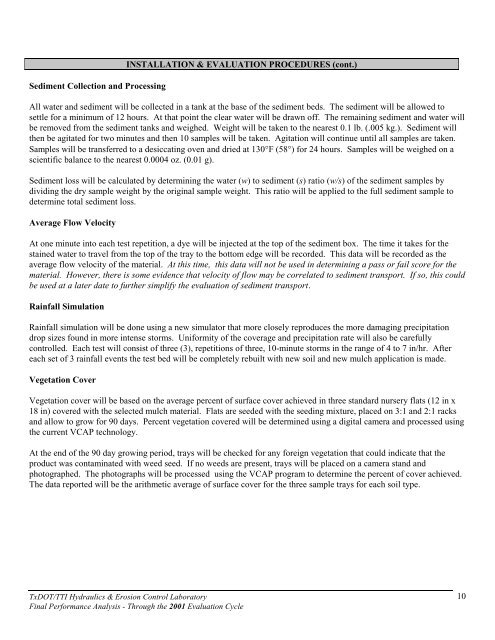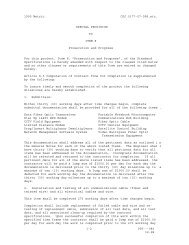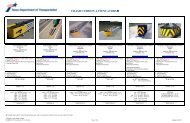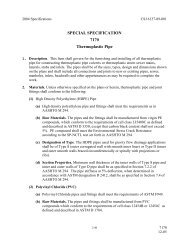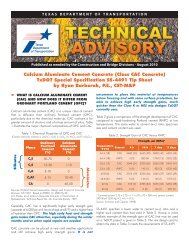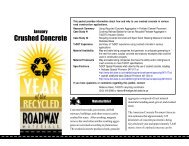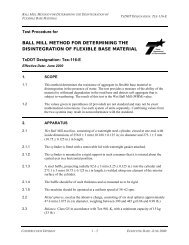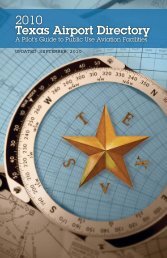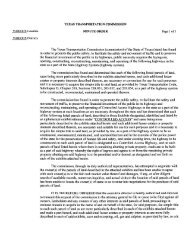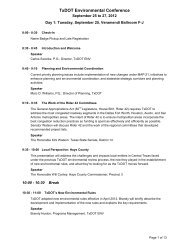TxDOT/TTI HYDRAULICS & EROSION CONTROL LABORATORY
TxDOT/TTI HYDRAULICS & EROSION CONTROL LABORATORY
TxDOT/TTI HYDRAULICS & EROSION CONTROL LABORATORY
Create successful ePaper yourself
Turn your PDF publications into a flip-book with our unique Google optimized e-Paper software.
Sediment Collection and Processing<br />
INSTALLATION & EVALUATION PROCEDURES (cont.)<br />
All water and sediment will be collected in a tank at the base of the sediment beds. The sediment will be allowed to<br />
settle for a minimum of 12 hours. At that point the clear water will be drawn off. The remaining sediment and water will<br />
be removed from the sediment tanks and weighed. Weight will be taken to the nearest 0.1 lb. (.005 kg.). Sediment will<br />
then be agitated for two minutes and then 10 samples will be taken. Agitation will continue until all samples are taken.<br />
Samples will be transferred to a desiccating oven and dried at 130°F (58°) for 24 hours. Samples will be weighed on a<br />
scientific balance to the nearest 0.0004 oz. (0.01 g).<br />
Sediment loss will be calculated by determining the water (w) to sediment (s) ratio (w/s) of the sediment samples by<br />
dividing the dry sample weight by the original sample weight. This ratio will be applied to the full sediment sample to<br />
determine total sediment loss.<br />
Average Flow Velocity<br />
At one minute into each test repetition, a dye will be injected at the top of the sediment box. The time it takes for the<br />
stained water to travel from the top of the tray to the bottom edge will be recorded. This data will be recorded as the<br />
average flow velocity of the material. At this time, this data will not be used in determining a pass or fail score for the<br />
material. However, there is some evidence that velocity of flow may be correlated to sediment transport. If so, this could<br />
be used at a later date to further simplify the evaluation of sediment transport.<br />
Rainfall Simulation<br />
Rainfall simulation will be done using a new simulator that more closely reproduces the more damaging precipitation<br />
drop sizes found in more intense storms. Uniformity of the coverage and precipitation rate will also be carefully<br />
controlled. Each test will consist of three (3), repetitions of three, 10-minute storms in the range of 4 to 7 in/hr. After<br />
each set of 3 rainfall events the test bed will be completely rebuilt with new soil and new mulch application is made.<br />
Vegetation Cover<br />
Vegetation cover will be based on the average percent of surface cover achieved in three standard nursery flats (12 in x<br />
18 in) covered with the selected mulch material. Flats are seeded with the seeding mixture, placed on 3:1 and 2:1 racks<br />
and allow to grow for 90 days. Percent vegetation covered will be determined using a digital camera and processed using<br />
the current VCAP technology.<br />
At the end of the 90 day growing period, trays will be checked for any foreign vegetation that could indicate that the<br />
product was contaminated with weed seed. If no weeds are present, trays will be placed on a camera stand and<br />
photographed. The photographs will be processed using the VCAP program to determine the percent of cover achieved.<br />
The data reported will be the arithmetic average of surface cover for the three sample trays for each soil type.<br />
<strong>TxDOT</strong>/<strong>TTI</strong> Hydraulics & Erosion Control Laboratory<br />
Final Performance Analysis - Through the 2001 Evaluation Cycle<br />
10


